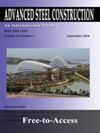INFLUENCE OF IMPERFECTIONS ON THE FLEXURAL RESISTANCE OF STEEL DELTA GIRDERS
IF 1.7
3区 工程技术
Q3 CONSTRUCTION & BUILDING TECHNOLOGY
引用次数: 6
Abstract
Residual stresses and geometrical imperfections are important factors that affect the inelastic lateral-torsional buckling (LTB) capacity of flexural members. In this paper, the influence of the magnitudes of residual stresses and initial geometrical imperfections in the form of member out-of-straightness on the flexural resistance of steel delta girders (SDG) is investigated. Based on test data reported for welded plates and monosymmetric welded I -sections, a residual stress pattern for SDG is proposed. Six different combinations of residual stress and geometrical imperfection magnitudes are then used in a finite element simulation study of a series of SDG under uniform bending and simply-supported boundary conditions. The flexural resistance curves computed for these SDG are compared with one another to demonstrate that both residual stresses and initial member out-of-straightness have a noticeable influence on the moment capacity of SDG, especially in the inelastic LTB region. These curves are also compared against the flexural strength equations provided in the current AISC specifications. The comparison reveals that the AISC equations often over-predict the flexural strength of SDG. An SDG flexural strength reduction factor is then proposed to allow for the design of these SDG using the AISC design equations. Received: Revised: Accepted: 23 December 2017 26 July 2018 12 August 2018缺陷对三角钢梁抗弯性能的影响
残余应力和几何缺陷是影响受弯构件非弹性侧扭屈曲能力的重要因素。本文研究了残余应力大小和以构件偏直形式存在的初始几何缺陷对三角钢梁抗弯性能的影响。基于已报道的焊接板和单对称焊接I型截面的试验数据,提出了SDG的残余应力图。然后,在均匀弯曲和简支边界条件下,采用六种不同的残余应力和几何缺陷大小组合对一系列SDG进行了有限元模拟研究。结果表明,残余应力和初始构件直线度对SDG的弯矩承载力有显著影响,特别是在非弹性LTB区域。这些曲线也与当前AISC规范中提供的抗弯强度方程进行了比较。对比表明,AISC方程对SDG抗弯强度的预测往往过高。然后提出了SDG抗弯强度折减系数,以便使用AISC设计方程设计这些SDG。收稿日期:2017年12月23日2018年7月26日2018年8月12日
本文章由计算机程序翻译,如有差异,请以英文原文为准。
求助全文
约1分钟内获得全文
求助全文
来源期刊

Advanced Steel Construction
CONSTRUCTION & BUILDING TECHNOLOGY-ENGINEERING, CIVIL
CiteScore
2.60
自引率
29.40%
发文量
0
审稿时长
6 months
期刊介绍:
The International Journal of Advanced Steel Construction provides a platform for the publication and rapid dissemination of original and up-to-date research and technological developments in steel construction, design and analysis. Scope of research papers published in this journal includes but is not limited to theoretical and experimental research on elements, assemblages, systems, material, design philosophy and codification, standards, fabrication, projects of innovative nature and computer techniques. The journal is specifically tailored to channel the exchange of technological know-how between researchers and practitioners. Contributions from all aspects related to the recent developments of advanced steel construction are welcome.
 求助内容:
求助内容: 应助结果提醒方式:
应助结果提醒方式:


